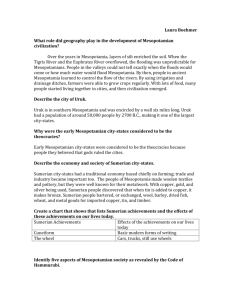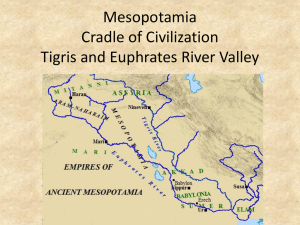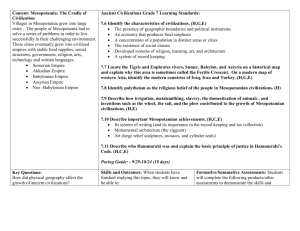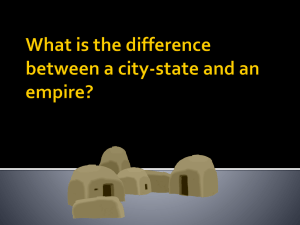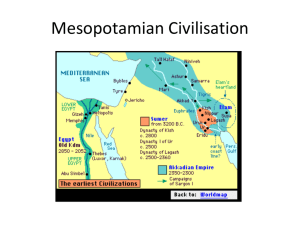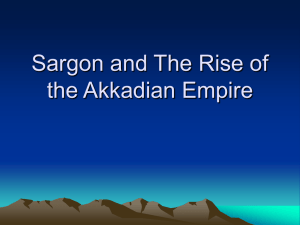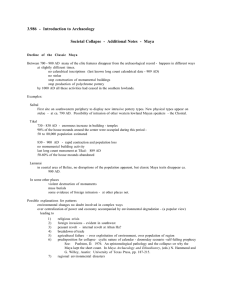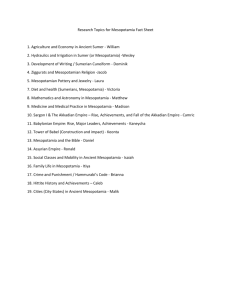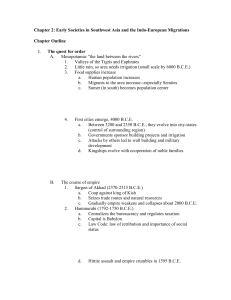The Bronze Age: Mesopotamia
advertisement
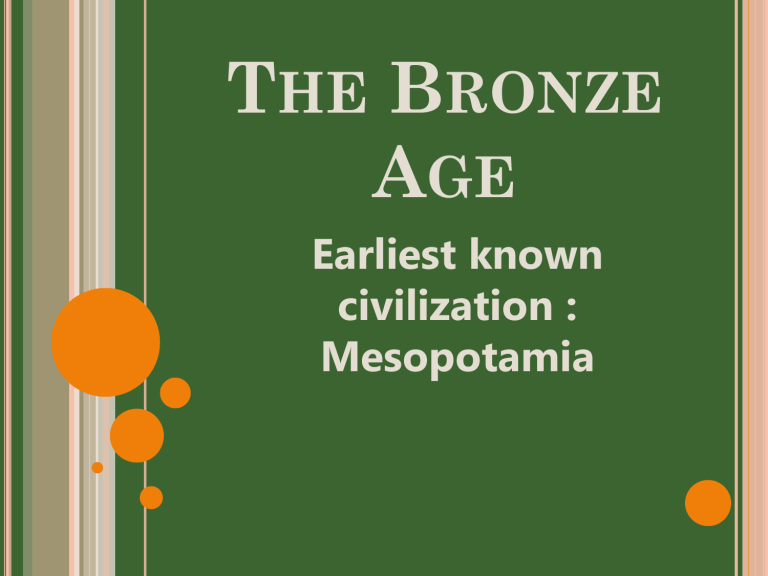
THE BRONZE AGE Earliest known civilization : Mesopotamia Mesopotamia is at the eastern end of the Fertile Crescent. Mesopotamia (“between the rivers”) Mesopotamia is located between the Tigris and Euphrates Rivers. Euphrates Tigris MESOPOTAMIA MESOPOTAMIA These rivers often overflow and leave silt, which makes the soil rich for a flourishing agricultural economy. Mesopotamian civilization was one of history’s important early civilizations. Developing consistent agriculture required controlling the water supply. People in Mesopotamia, therefore, developed a system of drainage ditches and irrigation works. MESOPOTAMIA The resulting large food supply made possible significant population growth and the emergence of civilization in Mesopotamia MESOPOTAMIAN CITY-STATES The Sumerians developed the first Mesopotamian civilization. City-states: were the basic political unit of the Sumerian civilization. MESOPOTAMIAN CITY-STATES The Sumerians invented the arch and the dome. The most important building in each city was the temple called a Ziggurat. Ziggurat of Ur (Iraq: Present Day) MESOPOTAMIAN RELIGION The Mesopotamians were Polytheistic. Polytheistic: Belief in more than one god or goddess. They were called the Annunaki. Each City-State had a chief god of the city, however they believed in all of the Annunaki MESOPOTAMIAN GOVERNMENT Stele of Ur-Nammu receiving his mandate from the god Enil to rule his people. The Sumerian citystates were theocracies (Theo meaning “god” and cracy meaning “rule”). In a theocracy, government authority is founded upon divine authority give by the gods. MESOPOTAMIAN ECONOMY The Sumerian economy was principally agricultural, but industry (metalwork and woolen textiles, for example) and trade were important. The invention of the wheel around 3000 B.C. facilitated trade. MESOPOTAMIAN SOCIAL CLASSES The Sumerian city-states had three classes: Nobles included the royal family, royal officials, priests, and their families. Commoners worked for large estates as farmers, merchants, fishers, and craftspeople. Around 90 percent of the people were farmers. Slaves principally worked on large building projects, wove cloth, and worked the farms of the nobles. BIRTH OF AN EMPIRE Sargon I (Left), Typical Akkadian Solders (Right) Empire: is a large political unit that controls many peoples and territories. The Akkadians are called a Semitic people because they spoke a Semitic language. Around 2340 B.C., the leader of the Akkadians, Sargon, conquered the Sumerian city-states and set up the world’s first empire. MESOPOTAMIAN MILLITARY Akkadian Heavy Infantry Akkadian Archer & Light Infantry Artwork by Robbie McSweeney Akkadian Commander THE WORLDS FIRST EMPIRE Sumer: c. 3200 B.C.E. Akkadian Empire: c. 2350 B.C.E EMPIRE AFTER EMPIRE In 1792 B.C., Hammurabi of Babylon, a city-state south of Akkad, established a new empire over much of both Akkad and Sumer. SYSTEM OF LAW The Code of Hammurabi is one of the world’s most important early systems of law. There are a set of 282 laws put forth to the people under Hammurabi's rule. It calls for harsh punishments against criminals, and was not applied equally to all people. The principle of retaliation (“an eye for an eye, a tooth for a tooth”) is fundamental in Hammurabi’s code. WRITING The Sumerians are most famous for their invention of a form of writing called Cuneiform. It is a series of dash and marks placed in a clay tablet with reads and the baked. Akkadian Cuneiform WRITING LETS MAKE A TIME LINE Pre-Pottery Neolithic A (10,000–8700 BC) Pre-Pottery Neolithic B (8700–6800) Hassuna (~6000 bc–? BC), Samarra (~5700 BC– 4900 BC) and Halaf (~6000 BC–5300 BC) Ubaid period (~5900–4400 BC) Uruk period (~4400–3100 BC) Jemdet Nasr period (~3100–2900 BC) Early Dynastic period (~2900–2350 BC) Akkadian Empire (~2350–2100 BC) Ur III period (2112–2004 BC) Early Assyrian kingdom (24th to 18th century BC) LETS MAKE A TIME LINE. Early Babylonia (19th to 18th century BC) First Babylonian Dynasty (18th to 17th century BC) collapse: Minoan Eruption (c. 1620 BC) Middle Assyrian period (16th to 11th century BC) Assyrian Empire (c. 1365 BC–1076 BC) Kassite dynasty in Babylon, (c. 1595 BC–1155 BC) collapse: Bronze Age collapse (12th to 11th century BC) Neo-Hittite or Syro-Hittite regional states (11th to 7th century BC) Neo-Assyrian Empire (10th to 7th century BC) Neo-Babylonian Empire (7th to 6th century BC) THE REPLAY VIDEO!
